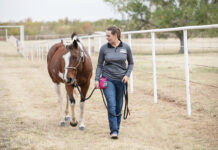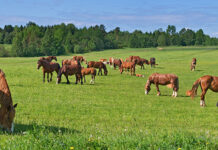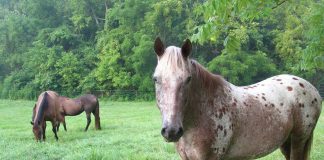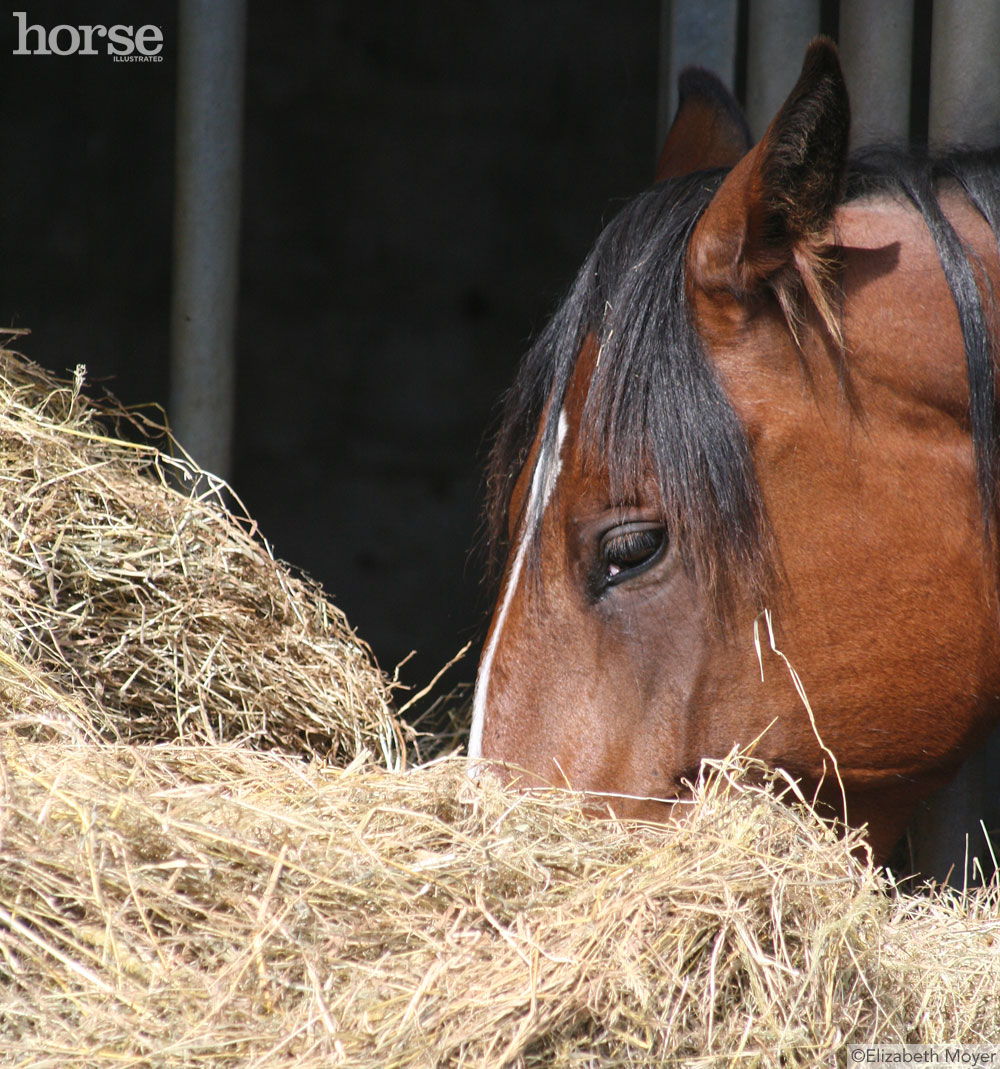
Hay First
A good starting place is to figure out what type of hay and how much of it your horse will need, assuming he has limited access to good pasture grazing. Horses should consume a minimum of around 2 percent of their body weight in forage per day; this comes to 20 pounds of hay for a 1,000-pound horse.
Hay should be high-quality—smell it for freshness (no musty odor), and look for any signs of mold, which can be blackish in color. Excessive weeds or any baled garbage is a sign of poor-quality hay.
Most areas sell grass hay, alfalfa, or a mixture of the two. Pure alfalfa is generally higher in calories than most horses need, and is consumed much faster, leaving the horse bored and hungry much of the day. Feed grass hay or a mix, if available, and use a small-hole hay net—you can even “double bag” if necessary—for a horse that tends to gobble it down too quickly.
Grain of Truth
Many people supplement their horse’s diet with grain without really thinking about it. Many companies make commercial grain formulations, also known as “concentrates,” for their concentrated calorie content. However, if feeding your horse grain, it’s important to feed the right type and amount.
These days, there’s a concentrate formulated for almost any type of horse, from the equine senior to broodmares and performance horses. Choose one that’s right for the amount of work your horse is doing. If you trail ride at the walk once a week, you don’t need to feed a performance grain.
Use the label on the grain bag to determine how much to feed. Many people skip this step, and their horse ends up getting shorted on vitamins and minerals. Most products recommend at least 5 pounds per day for an average-sized horse to ensure adequate nutrient consumption. If your horse needs more grain than that to stay at a healthy weight, break it up into enough feedings so that each meal is no more than ½ of a percent of his body weight (e.g. 5 pounds for a 1,000-pound horse). If a horse eats too much grain in one meal, some of it may reach the large intestine undigested and rapidly ferment, possibly causing colic.
If your horse needs fewer calories, switch to a ration balancer. Ration balancers are designed to be fed in a smaller amount of 1 to 2 pounds per day, and contain all the vitamins, minerals and protein your horse needs to supplement a hay diet.
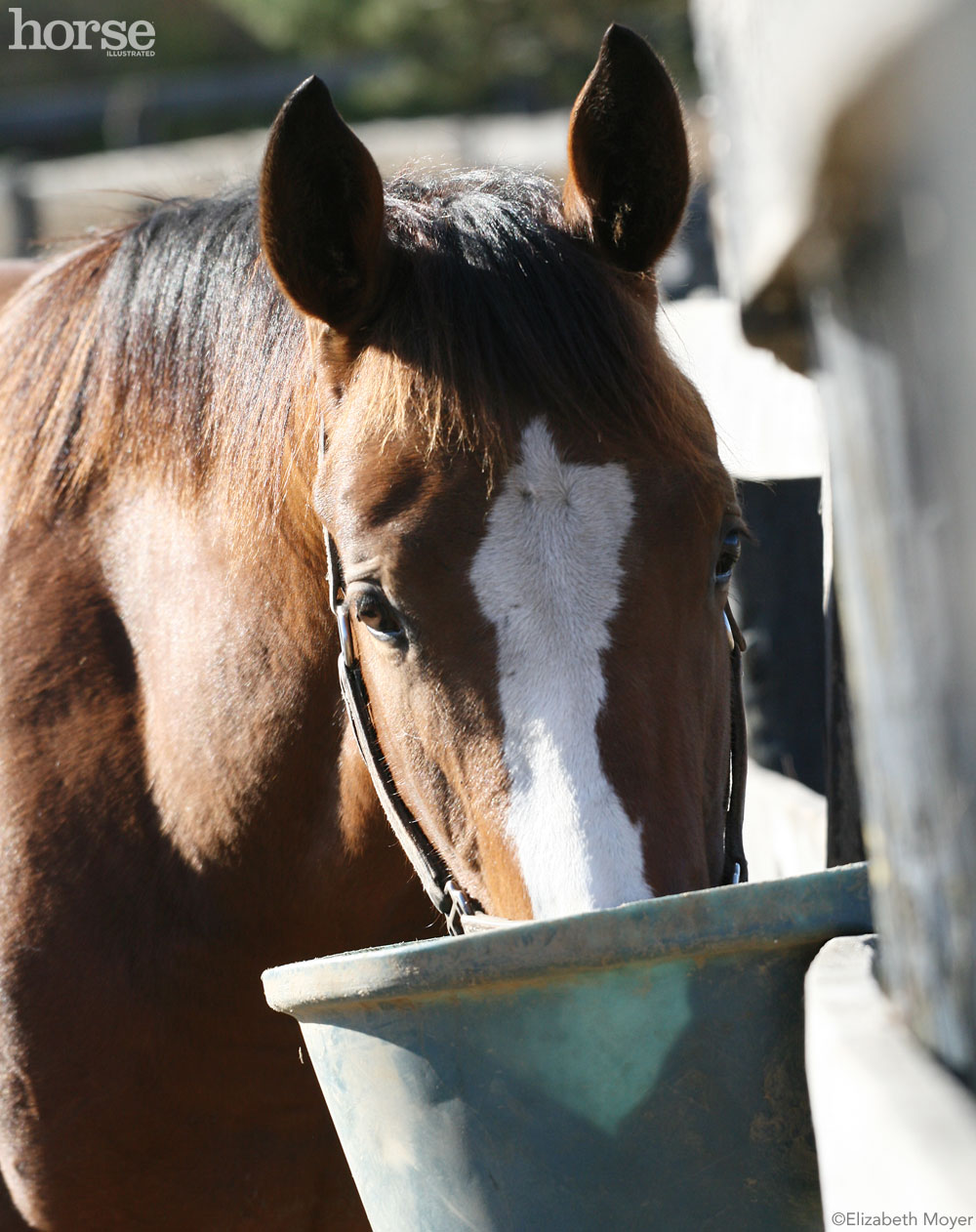
The Easy Keeper
Horses that tend toward being overweight are known as “easy keepers.” A diet of air seems to be enough to maintain them; often draft crosses, ponies and stocky breeds fit into this category. Equine obesity has been increasingly linked to serious health problems, such as insulin-resistance (IR), laminitis and metabolic syndrome.
First and foremost, these horses generally gain too much weight from unlimited grazing, and should either be kept in dry lots to encourage movement or wear a grazing muzzle if living on a grassy field.
If your horse lives in a stall or dry lot, you will have the challenge of providing him enough foraging time. Since long periods of hunger between meals are known to cause stomach ulcers and stable vices such as stall-walking, wood-chewing, cribbing, weaving, et cetera, it’s important to feed an easy keeper enough to occupy his mind and digestive system while also keeping his waistline whittled.
Exercise will go a long way toward shedding pounds, and you will probably want to consider replacing a grain mix with a ration balancer.
You can also switch from an alfalfa-mix hay to all-grass hay. Additionally, feeding hay that is harvested at a more mature growth stage, when it’s higher in fiber and lower in calories, is a good way to stave off weight gain if your horse will eat it. Some horses will eat any hay put in front of them, while others want only the tender early shoots. Slow-feeder systems may help prevent horses from eating too quickly if they insist on young hay, and stall and paddock toys may also prevent boredom between meals.
The Hard Keeper
At the other end of the spectrum is the horse that always seems a bit ribby, even if he’s fed the same amount or more than his plumper barnmates. It’s important to have a veterinarian confirm that there is no medical reason for his poor weight. Some health-related causes of weight loss include stomach ulcers, sharp points on the teeth that need to be floated (filed down), and an excessive parasite load. Get your horse’s deworming schedule on track based on his fecal egg count (FEC) tests and your vet’s advice. If there is no other illness at fault, then it’s time to increase the number of calories in his rations.
If you can switch to full-time turnout on good grass, these horses usually will gain weight. If grazing is not an option, an alfalfa-mix hay, or even straight alfalfa, will generally increase the calorie density of each bite of hay. Plus, horses usually eat more hay when fed alfalfa because they like the taste.
It’s important to be careful with your hard keeper’s grain ration to make sure you don’t just load him up with huge meals. It’s often more effective to supplement with a fiber source containing readily digestible calories, such as beet pulp, or a fat supplement such as rice bran or vegetable oil.
Beet pulp and rice bran, however, have an unbalanced mineral content and should not be over-fed. Experts recommend that the diet be no more than 25 percent beet pulp, with the remaining forage coming from other sources.
Some commercial feeds designed to aid in weight gain are high-fat/high-fiber, and maintain lower levels of sugars and starches while balancing all vitamins and minerals.
The Hot Horse
A high-strung, hyperactive horse—also called a “hot” horse—is one that has more energy than his rider would prefer during everyday activities. Some of this can be chalked up to inherent personality, but often the feeding program is a big contributor. As a very general rule, feeding a horse excess calories, starch and sugar—often found in grain—may create a more excitable animal.
Reducing the sugar-high effect can be accomplished by limiting grain in the diet and feeding good-quality hay, either grass or a grass-alfalfa mix. Although the foundation of every equine diet should be primarily forage (hay or pasture), horses that are exercised vigorously may need more calories than forage provides to maintain their weight. Similar to hard keepers, supplementing highly digestible fiber and fat, ideally in a balanced feed, is the best way to increase calorie density in the diet with the added benefit of avoiding excess sugar and starch.
Some people notice their horses acting hyper when fed straight alfalfa hay, although there is no scientific reasoning behind this. Alfalfa contains more protein than other types of hay, but protein does not directly make horses excitable. Some horse owners believe that certain feeds and supplements make their horses more high-strung. If your horse seems to be sensitive to a particular brand or ingredient, try changing to something else.
Lush spring grass in areas where horses mainly graze for forage can also be very high in calories and sugar and make horses excitable. Keep your horse off grass during this time and feed him hay instead if this causes a significant behavior problem.
Finally, a lack of turnout can also be the reason a horse is overly excitable. Give your horse as much turnout time as possible, especially if he’s the energetic type. Try to ride him regularly, at least five or six days a week if you can, to help channel his energy into improving his work under saddle.
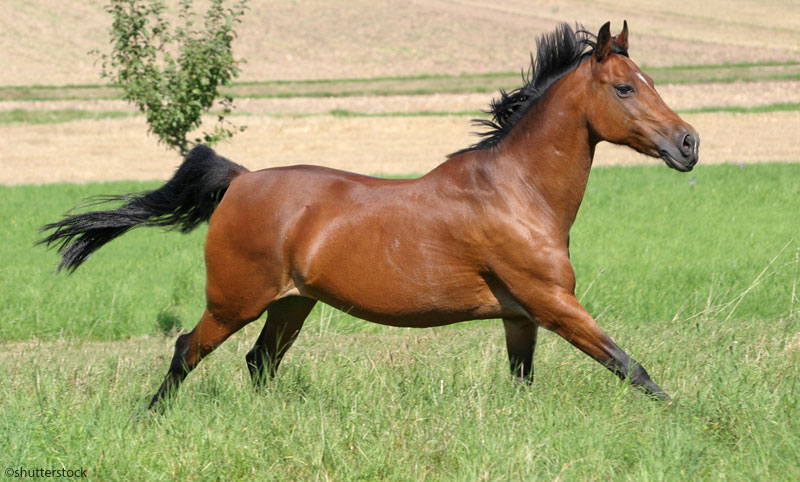
Senior Horse
Although some senior horses can continue eating what they’ve always eaten, others develop special needs as they lose weight, lose teeth, or develop metabolic diseases.
If your horse is in his late teens or early 20s and you’ve noticed him losing weight or muscle tone, have your vet out to check his teeth and possibly test for Cushing’s disease. Muscle wastage and a long, wavy haircoat that doesn’t shed out in summer are common symptoms of this disease, which is caused by a benign tumor on the pituitary gland.
Particularly for horses with poor teeth, soaking the feed is extremely important. Soaked hay cubes or pellets are best when the horse is missing teeth. He should also be separated from the herd during feeding time to avoid younger and bossier horses pushing him away from his bucket and eating his food.
Senior horses have slightly different nutrient requirements as they age, so supplementing the diet with a senior feed can be a good way to make sure he’s getting necessary nutrients.
Don’t be afraid to ride your senior horse if he is sound. A little exercise is great for his joints and mind, and will keep him healthy.
Every horse is an individual, so it’s essential to tailor his diet to meet his specific needs. Always make sure to offer unlimited clean, fresh water (the most important nutrient) and a free-choice salt block. Particularly in the summer, horses need more salt than what is contained in their forage and grain.
Keep a careful eye on your new horse’s weight and health, and consult with your vet if you think his feeding plan needs adjustments.
This article originally appeared in the 2015 edition of Your New Horse.


